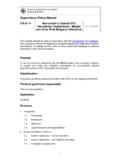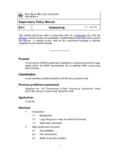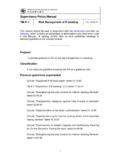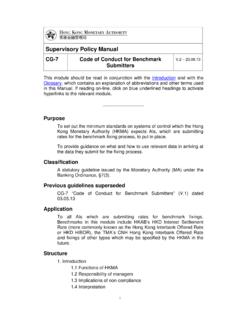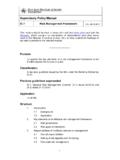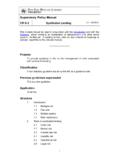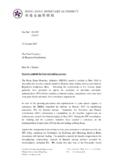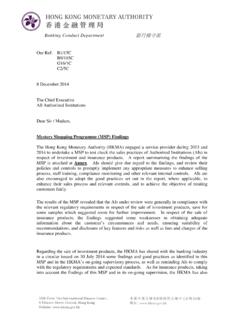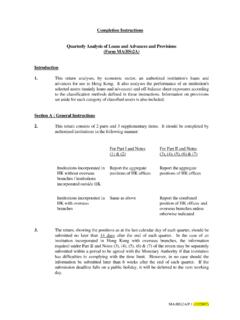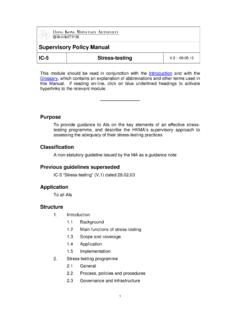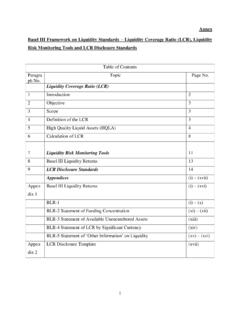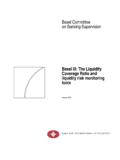Transcription of Supervisory Policy Manual - Hong Kong dollar
1 Supervisory Policy Manual LM-1 Regulatory Framework for Supervision of liquidity Risk 1 This module should be read in conjunction with the Introduction and with the Glossary, which contains an explanation of abbreviations and other terms used in this Manual . If reading on-line, click on blue underlined headings to activate hyperlinks to the relevant module. Purpose To provide guidance to AIs on the application of the Banking ( liquidity ) Rules Classification A statutory guideline issued by the MA under the Banking Ordinance, 7(3) Previous guidelines superseded LM-1 liquidity Risk Management ( ) dated Application To all AIs Structure 1.
2 Introduction 2. Approach to supervising liquidity risk 3. Statutory liquidity requirements liquidity coverage Ratio (LCR) liquidity Maintenance Ratio (LMR) Implementation of LCR or LMR on Hong Kong office basis, unconsolidated basis and consolidated basis Notification of liquidity events and Supervisory responses Internal targets and limits 4. Determination of category 1 and category 2 institutions Supervisory Policy Manual LM-1 Regulatory Framework for Supervision of liquidity Risk 2 General Designation of category 1 institutions Revocation of designation Application for designation (or revocation of designation) Ongoing review of designation 5.
3 Application of LCR Structure of LCR High quality liquid assets (HQLA) Level 1 assets Level 2A assets Level 2B assets Ceilings on level 2 assets Alternative liquidity Approach (ALA) Total net cash outflows Monetization of HQLA under financial stress 6. Application of LMR Structure of LMR Liquefiable assets Qualifying liabilities Deductions from qualifying liabilities 7. liquidity disclosure standard Disclosure of LCR or LMR information Disclosure of information on liquidity risk management Supervisory Policy Manual LM-1 Regulatory Framework for Supervision of liquidity Risk 3 Other liquidity information Disclosure Policy Annex 1: Assets regarded as free from encumbrances under LCR or LMR Annex 2: Guidance on treatment of RMBS under LCR or LMR Supervisory Policy Manual LM-1 Regulatory Framework for Supervision of liquidity Risk 4 1.
4 Introduction liquidity risk is the risk that an authorized institution (AI) may not be able to meet its obligations as they fall due without incurring unacceptable losses. This may be caused by an AI s inability to liquidate assets or to obtain funding to meet its liquidity needs, whether because of institution-specific reasons or market stress. liquidity problems can have an adverse impact on an AI s earnings and capital and, in extreme circumstances, can lead to the collapse of an AI.
5 A liquidity stress besetting individual AIs that play an active or major role in financial activities may have systemic consequences for other AIs and the banking system as a whole. It could also affect the proper functioning of payment systems and other financial markets. Sound liquidity risk management is therefore pivotal to the viability of every AI and the maintenance of overall banking stability. To promote the resilience of banks and banking systems to liquidity stress, the Basel Committee on Banking Supervision (BCBS) has issued a set of Principles for Sound liquidity Risk Management and Supervision to strengthen international standards in this area.
6 In addition, two quantitative metrics have been introduced by the BCBS as minimum international standards for liquidity management and supervision: the liquidity coverage Ratio (LCR), which came into operation from 1 January 2015; and the Net Stable Funding Ratio (NSFR), which will commence effect from 1 January 2018. (The local regulations implementing the NSFR will be issued in due course.) In Hong Kong, it is one of the ongoing minimum criteria for authorization (provided in paragraph 7 of the Seventh Schedule to the Banking Ordinance (BO)) that the Monetary Authority (MA)1 should be satisfied that an AI, on and after 1 In this module, the term MA refers to Monetary Authority (the person exercising the legal authority under the Banking Ordinance)
7 Or Hong Kong Monetary Authority (the office of the Monetary Authority), as the context so requires. Supervisory Policy Manual LM-1 Regulatory Framework for Supervision of liquidity Risk 5 authorization, maintains adequate liquidity to meet its obligations as they will or may fall due; and complies with the rules2 made by the MA under 97H(1) of the BO. In this regard, the MA has made the Banking ( liquidity ) Rules (BLR) under 97H(1) to prescribe the requirements in respect of the LCR, which is applied to AIs designated by the MA as category 1 institutions ; and the liquidity Maintenance Ratio (LMR), a local liquidity standard developed by the MA for application to all other AIs that are not designated as category 1 institutions, and which are referred to as category 2 institutions.
8 Moreover, the MA has issued a Code of Practice3 (the Code) under 97M of the BO to supplement the implementation of the LCR. Standard calculation templates are also included in the Return of liquidity Position of an Authorized Institution (MA(BS)1E) to facilitate the calculation and reporting of the LCR or LMR by different categories of AIs. This module (i) provides an overview of the regulatory framework adopted by the MA for supervising AIs liquidity risk; and (ii) sets out the approach the MA will take in assessing AIs compliance with the statutory liquidity requirements provided in the BLR.
9 Failure of an AI to adhere to the guidelines in this module may call into question whether the AI continues to satisfy the authorization criterion set out in paragraph 7 of the Seventh Schedule to the BO. AIs are also reminded that merely complying with the statutory liquidity requirements in the BLR or meeting the guidelines set out in this module is not of itself sufficient to constitute prudent liquidity risk management. In particular, AIs should adopt additional sound systems and controls tailored to their liquidity risk profiles, having regard to the size, nature and complexity of 2 Unless otherwise specified, any rule cited in this module means a rule included in the BLR.
10 3 This refers to the Banking ( liquidity coverage Ratio Calculation of Total Net Cash Outflows) Code, issued by the MA in December 2014. Supervisory Policy Manual LM-1 Regulatory Framework for Supervision of liquidity Risk 6 their businesses and activities. Please refer to the Supervisory Policy Manual (SPM) module LM-2 Sound Systems and Controls for liquidity Risk Management for details. This module should be read in conjunction with the BLR, the Code, the Completion Instructions (CIs) for Return MA(BS)1E, SPM module LM-2 and other relevant Supervisory documents that may be issued by the MA.
